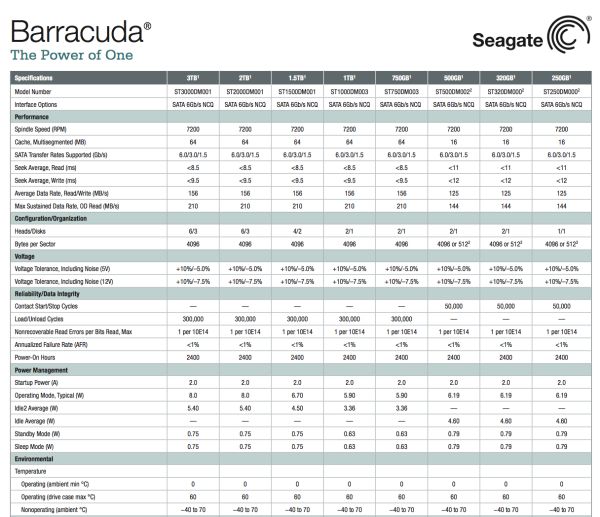Seagate Introduces New 1TB-Per-Platter Barracuda, Solid State Hybrid Version Coming
by Anand Lal Shimpi on November 1, 2011 8:00 AM ESTYesterday Seagate had three members of its Barracuda family of 3.5" hard drives: the Barracuda Green, Barracuda, and Barracuda XT. Today, all three lines are being folded under the Barracuda name. The Barracuda Green drives will cease production in February 2012. The Barracuda XT, Seagate's flagship 3.5" drive, will eventually be replaced by a solid state Hybrid drive at some point in the future. Until then, if you want a 3.5" hard drive from Seagate - it'll just be called a Barracuda.
The new Barracuda lineup is top-to-bottom 7200RPM. Seagate makes up for the extra power required to spin at 7200RPM (vs 5900RPM for the Green drives) by moving to 1TB platters and a faster cache. Increasing platter density has been the preferred route of increasing performance in hard drives over the past decade, causing spindle speeds to stagnate but sequential transfer rates to increase steadily. The new 1TB-per-platter Barracuda disks are no exception. Despite not carrying the XT label, the new 3TB drive is capable of noticeably higher sequential read/write speeds compared to the outgoing Barracuda XT.

Seagate also updated the controller (now built on a 40nm process) and DRAM (now up to 64MB of DDR2) on the new Barracuda line. The 1TB platter drives are available in 1TB, 1.5TB, 2TB and 3TB capacities. Their prices and model numbers are below:
| Seagate's 1TB-per-platter Barracuda Lineup | ||||
| Model Number | Capacity | MSRP | ||
| ST3000DM001 | 3TB | $179.99 | ||
| ST2000DM001 | 2TB | $105.99 | ||
| ST1500DM001 | 1.5TB | $83.99 | ||
| ST1000DM003 | 1TB | $71.99 | ||
We'll have a full review of the new 3TB flagship drive later today.











36 Comments
View All Comments
LeftSide - Tuesday, November 1, 2011 - link
It would be nice to have a complete breakdown of the Hard drive in terms of sectors size. There is a lot of confusion going around as to what drives are 4k vs 512e vs native 512byte. I just built a ZFS box with mirrored Hitachi 3tb 7200rpm drives (HDS72303), and I still don't know whether they are using 512byte sectors or 512e.DigitalFreak - Tuesday, November 1, 2011 - link
It's in the chart. All the 750GB and larger drives are 4k sectors.icrf - Tuesday, November 1, 2011 - link
physical, yes, but I'm more interested in the sector size reported by the firmware. I've got these WD drives that refuse to be honest and cause problems.LeftSide - Wednesday, November 2, 2011 - link
Exactly.zanon - Tuesday, November 1, 2011 - link
While some older 1TB and so forth did use 512k, at this point virtually anything new is 4k (although sadly probably not native), and anything over a TB for sure. You should useashift=12
as a creation option when you create your zpool in order to make sure ZFS knows about the real sector size and can optimize accordingly. You should consider doing this with a new pool *anyway* even if for some reason you were still using 512k, because the performance impact is minimal, but while 512k disks can be added to an ashift=12 zpool, native 4k disks can *not* be added to an ashift=9 pool. So in the near future when we hopefully start seeing native 4k disk available a 4k pool setup will have forward compatibility, whereas you'd have to destroy and recreate a pool to upgrade even a single disk otherwise. That might not matter if it's something tiny (a single mirror) but it'll be a bigger deal if you make something larger that you'd really rather be able to upgrade a disk at a time (or replace a bad disk without worry).
Gnarr - Tuesday, November 1, 2011 - link
So they only utilize 750GB of two platters? or how does that sum up?InterClaw - Tuesday, November 1, 2011 - link
Maybe it has one and a half platters inside. :)rahvin - Tuesday, November 1, 2011 - link
Closer than you know. 2 Full platters. Only Half of one of them is being used. They've been doing that for years. It's like an artificially lowered clock count on a CPU, the power is there, you just can't use it. You pay for a full two platter drive they just turn off half of one platter with software so you only see 1.5 TB instead of the 2 TB physically there.FaaR - Tuesday, November 1, 2011 - link
They're not using HALF a platter... They're using all of one side of a platter, IE, a two-platter drive would have 3 heads rather than the expected 4. Saves a little on hardware, and in the HDD business today, every penny is worth clinging on to.Not that this is anything new or anything, this practice stretches back to the 1980s at least.
semo - Tuesday, November 1, 2011 - link
They've probably short-stroked them.